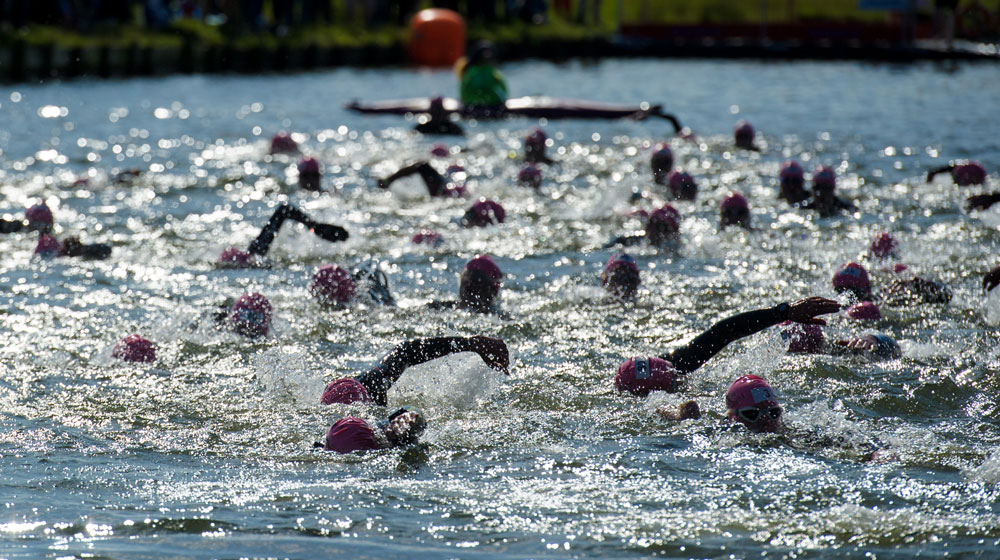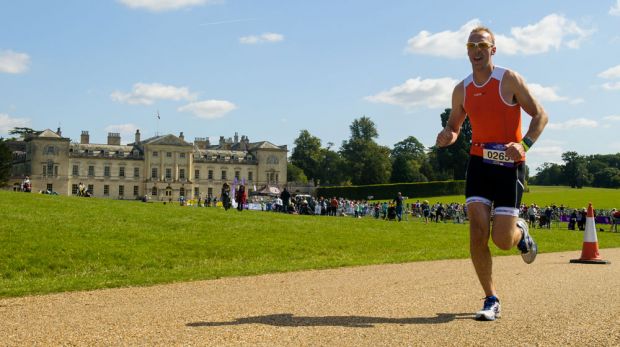
Once you’ve thrashed out a few Olympic-distance triathlons and decided that it’s time to make the leap to a half Ironman, this training plan from endurance coach Steve Whittle will help you to do just that.
“If you’re comfortable with the Olympic distance, this 12-week plan will allow you to progress to the half Ironman,” says Whittle. If you haven’t completed an Olympic tri, sign up for that distance first and use Whittle’s Olympic triathlon training plan to guide you.
We've also got some triathlon training tips from tri coaches, below the training plan.
How long is a half Ironman triathlon?
A half Ironman consists of a 1.2-mile/1.9km swim, 56-mile/90km cycle and a 13.1-mile/21.1km run. It typically takes somewhere between five and eight hours for amateurs to complete a half Ironman, though this will vary significantly based on the course and conditions. It’s a significant step up from an Olympic triathlon, which typically takes amateurs around three hours to complete.
12-Week Half Ironman Triathlon Training Plan
The plan below has been specifically designed to help intermediate-level triathletes prepare for the 1.9km swim, 85km ride and 21.1km run of the Woburn Abbey Half-Iron, presented by tri for life.
The plan keeps things simple and uses duration for each session. This ensures the body gets used to working for sustained periods and you don’t need to worry about covering specific distances. It also makes it easier to schedule all the hours of training in around other commitments.
Week 1
| Monday | Rest |
| Tuesday | Bike 60min |
| Wednesday | Swim 45min and run 30min |
| Thursday | Bike 90min |
| Friday | Swim 30min and run 30min |
| Saturday | Bike 90min |
| Sunday | Run 50min (with hills) |
Week 2
| Monday | Rest |
| Tuesday | Bike 60min |
| Wednesday | Swim 45min and run 35min |
| Thursday | Bike 1hr 45min |
| Friday | Swim 45min and run 35min |
| Saturday | Bike 2hr |
| Sunday | Run 60min (with hill sprints) |
Week 3
| Monday | Rest |
| Tuesday | Bike 1hr 15min |
| Wednesday | Swim 45min and run 35min |
| Thursday | Bike 1hr 45min |
| Friday | Swim 45min and run 40min |
| Saturday | Bike 2hr |
| Sunday | Swim 30min and run 65min (with hill sprints) |
Week 4
| Monday | Rest |
| Tuesday | Bike 1hr 15min |
| Wednesday | Swim 45min and run 35min |
| Thursday | Bike 1hr 15min |
| Friday | Swim 45min and run 45min |
| Saturday | Bike 2hr 15min |
| Sunday | Swim 30min and run 70min |
Week 5
| Monday | Rest |
| Tuesday | Bike 60min |
| Wednesday | Swim 45min and run 30min |
| Thursday | Bike 90min |
| Friday | Bike 30min and swim 45min |
| Saturday | Run 40min and bike 2hr |
| Sunday | Swim 30min and run 1hr 5min |
Week 6
| Monday | Rest |
| Tuesday | Bike 90min |
| Wednesday | Swim 50min and run 50min |
| Thursday | Bike 2hr |
| Friday | Swim 50min and run 45min |
| Saturday | Bike 3hr |
| Sunday | Swim 30min and run 1hr 25min |

Week 7
| Monday | Rest |
| Tuesday | Bike 60min |
| Wednesday | Swim 50min and run 40min |
| Thursday | Bike 90min |
| Friday | Swim 50min and run 35min |
| Saturday | Bike 2hr 30min |
| Sunday | Swim 40min and run 1hr 25min |
Week 8
| Monday | Rest |
| Tuesday | Bike 90min |
| Wednesday | Swim 50min and run 50min |
| Thursday | Bike 2hr |
| Friday | Swim 50min and run 50min |
| Saturday | Bike 3hr |
| Sunday | Swim 40min and run 90min |
Week 9
| Monday | Rest |
| Tuesday | Bike 60min |
| Wednesday | Swim 55min and run 45min |
| Thursday | Bike 90min |
| Friday | Swim 55min and run 40min |
| Saturday | Bike 2hr 30min |
| Sunday | Swim 30min and run 1hr 35min |
Week 10
| Monday | Rest |
| Tuesday | Bike 90min |
| Wednesday | Swim 60min and run 55min |
| Thursday | Bike 2hr |
| Friday | Swim 60min and run 50min |
| Saturday | Bike 3hr 15min |
| Sunday | Swim 40min and run 1hr 45min |
Week 11
| Monday | Rest |
| Tuesday | Bike 1hr 15min |
| Wednesday | Swim 60min and run 40min |
| Thursday | Bike 90min |
| Friday | Swim 60min and run 40min |
| Saturday | Bike 2hr 30min |
| Sunday | Swim 30min and run 1hr 10min |
Week 12
| Monday | Rest |
| Tuesday | Bike 90min |
| Wednesday | Swim 40min and run 30min |
| Thursday | Rest |
| Friday | Swim 10min and bike 30min |
| Saturday | Race Day |
Triathlon Training Tips
Fuel Your Engine
Aim to eat a meal containing a mix of complex and simple carbohydrates, plus some lean protein and healthy fats, two to three hours before your session. Scrambled eggs on wholemeal toast with some fresh fruit is a good example—it’s light and easy to digest and it’ll provide you with a sustained energy boost.
Improve Your Swimming Technique
If you are more efficient in the water, you’ll save energy for the rest of your half Ironman while still speeding through your swim. “Find a group to train with, or get a few private coaching lessons,” says triathlon coach Ian Rooke, who contributed to our guide on how to train for a triathlon. A dedicated tri coach is a better bet because tri swimming technique uses less kicking than traditional front crawl, conserving energy for the road.
Sign up for workout ideas, training advice, reviews of the latest gear and more.
Practice Swimming In A Wetsuit
“While wetsuits are great at providing extra warmth and hydrodynamics, they can feel tight and restricting at first,” says Phil Paterson of coaching company RG Active. “It’s important to work with the buoyancy of the wetsuit. The suit’s buoyancy should make everyone quicker, since you sit higher in the water and your legs don’t sink as much.”
Don’t Just Train Indoors
This goes for all three disciplines in the half Ironman. While smashing out sessions in the gym is convenient and great for your fitness, the best prep for your event will be outdoors.
“You need to learn how to tackle wind and rain, particularly on the bike where you’ll be required to brake and corner,” says Paterson. “Another key area not being used when training indoors are the stabilizing muscles in your hips and core, which are essential for efficient running and pedaling. Not only can weaker stabilizing muscles slow you down through inefficiency, they can also lead to a greater risk of injury.”
Between 2010 and 2016, Ben was the deputy editor of Men’s Fitness UK, which predated, and then shared a website with, Coach. Ben also contributed exclusive features to Coach on topics such as football drills, triathlon training plans and healthy eating.

